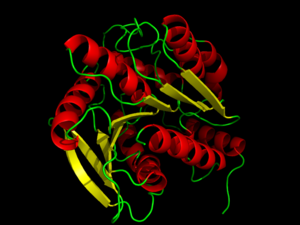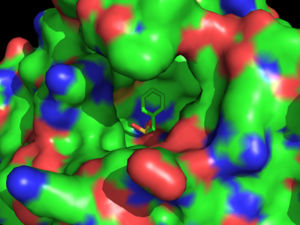Hormone sensitive lipase
From Proteopedia
(Difference between revisions)
(New page: ==Hormone-sensitive lipase== <StructureSection load='3DNM' size='450' side='right' caption='Hormone-Sensitive Lipase (PDB: 3dnm' scene='58/580297/3dnm_cartoon/2' > ==Introduction== [...) |
|||
| Line 1: | Line 1: | ||
==Hormone-sensitive lipase== | ==Hormone-sensitive lipase== | ||
| - | <StructureSection load='3DNM' size='450' side='right' caption='Hormone-Sensitive Lipase (PDB: [[ | + | <StructureSection load='3DNM' size='450' side='right' caption='Hormone-Sensitive Lipase (PDB: [[3DNM]])' scene='58/580297/3dnm_cartoon/2' > |
==Introduction== | ==Introduction== | ||
| Line 9: | Line 9: | ||
====Activation of HSL==== | ====Activation of HSL==== | ||
Briefly, HSL is stimulated by the binding of catecholamines to β-adrenergic receptors. β-adrenergic receptors coupled with [http://www.proteopedia.org/wiki/index.php/Adenylate_Cyclase adenylate cyclase] (AC) then stimulate G-proteins to increase the levels of cystolic [http://en.wikipedia.org/wiki/Cyclic_adenosine_monophosphate cAMP]. Elevated levels of cAMP leads to an activation [http://www.proteopedia.org/wiki/index.php/Protein_kinase_A protein kinase A] (PKA) leading to phosphorylation of serine residues on HSL activating and translocating HSL to lipid droplets for lipolysis. Conversely, insulin signaling decreases cystolic cAMP levels, resulting in a decreased HSL mobilization.<ref name="Holm">PMID:14641008</ref> | Briefly, HSL is stimulated by the binding of catecholamines to β-adrenergic receptors. β-adrenergic receptors coupled with [http://www.proteopedia.org/wiki/index.php/Adenylate_Cyclase adenylate cyclase] (AC) then stimulate G-proteins to increase the levels of cystolic [http://en.wikipedia.org/wiki/Cyclic_adenosine_monophosphate cAMP]. Elevated levels of cAMP leads to an activation [http://www.proteopedia.org/wiki/index.php/Protein_kinase_A protein kinase A] (PKA) leading to phosphorylation of serine residues on HSL activating and translocating HSL to lipid droplets for lipolysis. Conversely, insulin signaling decreases cystolic cAMP levels, resulting in a decreased HSL mobilization.<ref name="Holm">PMID:14641008</ref> | ||
| - | |||
==Structure of hormone-sensitive lipase== | ==Structure of hormone-sensitive lipase== | ||
<scene name='58/580297/3dnm_cartoon_dotsribbon/1'>Hormone-sensitive lipases</scene> are generally well-conserved across domains, including prokaryotes, showing 29, 26, and 22% residue overlap in [http://en.wikipedia.org/wiki/Alicyclobacillus ''Alicyclobacillus acidocaldarius''], [http://en.wikipedia.org/wiki/Archaeoglobus ''Archaeoglobus fulgidus''], and [http://en.wikipedia.org/wiki/Bacillus_subtilis ''Bacillus subtilis''], respectively.<ref name="Nam">PMID:19089974</ref> HSL is composed of two main structural domains, consisting of a slightly variable N-terminus (shown in blue in the <scene name='58/580297/3dnm_cartoon/3'>default view</scene>) that is thought to contribute to numerous factors including activity, specificity, regioselectivity, thermophilicity, and thermostability.<ref name="Nam">PMID:19089974</ref> Research speculates that the N-terminal domain, consisting of about 300 residues, mediates protein-protein interactions, and possibly subsequent lipid binding.<ref name= "Yeaman">PMID:14725507</ref> The second domain of HSL is the C-terminal catalytic domain (colors other than blue), which contains serine residue phosphorylation sites as well as the [http://en.wikipedia.org/wiki/Catalytic_triad catalytic triad], viewed <scene name='58/580297/3dnm_triad_zoomedout/1'>here</scene> with ligand β-mercaptoethanol, a charge relay network that is characteristic of many hydrolases, such as [http://proteopedia.org/wiki/index.php/Chymotrypsin chymotrypsin].<ref name= "Yeaman">PMID:14725507</ref> With respect to sequence conservation across species, it has been shown that the catalytic domain, including the triad, is conserved across domains, but the domain containing the N-terminus shows little conservation.<ref name="Nam">PMID:19089974</ref> Size-exclusion chromatography studies have shown that HSL has a <scene name='58/580297/3dnm_cartoon_surface/4'>ligand pocket</scene> that is approximately 16Å deep, suggesting that HSL primarily hydrolyzes shorter chained molecules.<ref name="Nam">PMID:19089974</ref> | <scene name='58/580297/3dnm_cartoon_dotsribbon/1'>Hormone-sensitive lipases</scene> are generally well-conserved across domains, including prokaryotes, showing 29, 26, and 22% residue overlap in [http://en.wikipedia.org/wiki/Alicyclobacillus ''Alicyclobacillus acidocaldarius''], [http://en.wikipedia.org/wiki/Archaeoglobus ''Archaeoglobus fulgidus''], and [http://en.wikipedia.org/wiki/Bacillus_subtilis ''Bacillus subtilis''], respectively.<ref name="Nam">PMID:19089974</ref> HSL is composed of two main structural domains, consisting of a slightly variable N-terminus (shown in blue in the <scene name='58/580297/3dnm_cartoon/3'>default view</scene>) that is thought to contribute to numerous factors including activity, specificity, regioselectivity, thermophilicity, and thermostability.<ref name="Nam">PMID:19089974</ref> Research speculates that the N-terminal domain, consisting of about 300 residues, mediates protein-protein interactions, and possibly subsequent lipid binding.<ref name= "Yeaman">PMID:14725507</ref> The second domain of HSL is the C-terminal catalytic domain (colors other than blue), which contains serine residue phosphorylation sites as well as the [http://en.wikipedia.org/wiki/Catalytic_triad catalytic triad], viewed <scene name='58/580297/3dnm_triad_zoomedout/1'>here</scene> with ligand β-mercaptoethanol, a charge relay network that is characteristic of many hydrolases, such as [http://proteopedia.org/wiki/index.php/Chymotrypsin chymotrypsin].<ref name= "Yeaman">PMID:14725507</ref> With respect to sequence conservation across species, it has been shown that the catalytic domain, including the triad, is conserved across domains, but the domain containing the N-terminus shows little conservation.<ref name="Nam">PMID:19089974</ref> Size-exclusion chromatography studies have shown that HSL has a <scene name='58/580297/3dnm_cartoon_surface/4'>ligand pocket</scene> that is approximately 16Å deep, suggesting that HSL primarily hydrolyzes shorter chained molecules.<ref name="Nam">PMID:19089974</ref> | ||
| + | |||
====Catalytic triad==== | ====Catalytic triad==== | ||
The catalytic triad <scene name='58/580297/3dnm_triad_zoomedin/1'>situates itself</scene> with β-mercaptoethanol toward the middle of HSL. The catalytic triad is composed of residues <scene name='58/580297/3dnm_ligandsite_triad_chains/4'>Ser157, Glu251, and His281</scene>. The Ser157 residue sits at a site deemed the "nucleophilic elbow," that models an approximate torsion of Φ = 60° and Ψ =-120°.<ref name="Nam">PMID:19089974</ref> This nucleophilic elbow is stabilized by a hydrogen bond between the proximal nitrogen and oxygen atoms of His281 and Glu251, respectively. This model also shows the strong nucleophilic character of Ser157, portraying the interaction and subsequent covalent bonding (not shown) to <scene name='58/580297/3dnm_ligandsite_triad_chains/3'>β-mercaptoethanol</scene>. Return to default view, <scene name='58/580297/3dnm_cartoon/3'>here</scene>.<ref name= "Yeaman">PMID:14725507</ref> | The catalytic triad <scene name='58/580297/3dnm_triad_zoomedin/1'>situates itself</scene> with β-mercaptoethanol toward the middle of HSL. The catalytic triad is composed of residues <scene name='58/580297/3dnm_ligandsite_triad_chains/4'>Ser157, Glu251, and His281</scene>. The Ser157 residue sits at a site deemed the "nucleophilic elbow," that models an approximate torsion of Φ = 60° and Ψ =-120°.<ref name="Nam">PMID:19089974</ref> This nucleophilic elbow is stabilized by a hydrogen bond between the proximal nitrogen and oxygen atoms of His281 and Glu251, respectively. This model also shows the strong nucleophilic character of Ser157, portraying the interaction and subsequent covalent bonding (not shown) to <scene name='58/580297/3dnm_ligandsite_triad_chains/3'>β-mercaptoethanol</scene>. Return to default view, <scene name='58/580297/3dnm_cartoon/3'>here</scene>.<ref name= "Yeaman">PMID:14725507</ref> | ||
| Line 19: | Line 19: | ||
[[Image:SURFACEINHIBITOR.png|300 px|left|thumb|Surface image of Hormone-Sensitive Lipase Complex with PMSF from [http://proteopedia.org/wiki/index.php/3h17 3h17]. Green indicates carbon atoms, blue indicates nitrogen atoms, red indicates oxygen atoms, and orange indicates sulfur atoms.]] | [[Image:SURFACEINHIBITOR.png|300 px|left|thumb|Surface image of Hormone-Sensitive Lipase Complex with PMSF from [http://proteopedia.org/wiki/index.php/3h17 3h17]. Green indicates carbon atoms, blue indicates nitrogen atoms, red indicates oxygen atoms, and orange indicates sulfur atoms.]] | ||
| - | Hormone-sensitive lipase can be inhibited by phenylmethylsufonyl flouride ([http://en.wikipedia.org/wiki/PMSF PMSF]) covalently bound to the <scene name='58/580297/Pmsf_surface/4'>active site</scene>. The experiments performed to test this inhibition used different lipases obtained from [http://en.wikipedia.org/wiki/Bacillus_coagulans ''Bacillus coagulans''] as well as lipases from different areas of the human body.<ref name="Kanwar">PMID:23923547</ref> PMSF inhibits hydrolase by binding to the catalytic serine residue of the [http://proteopedia.org/wiki/index.php/Serine_Proteases serine protease] active site which disrupts the nucleophilic activity of the catalytic serine. The sulfur of PMSF binds to the oxygen of the hydroxyl group on the serine residue to form this covalent bond. This inhibitor will only bind to the active site of the catalytic serine because of its participation in the charge relay of the catalytic triad. This hyper activity, indicated by increased temperature (shown in red) around the active site <scene name='58/580296/Meshligand/3'>here</scene>, allows the sulfonyl group of PMSF to covalently bind to the catalytic serine residue to disrupt its activity.<ref name="Kim">PMID: 19715665 </ref> Because of this catalytic serine residue specificity, PMSF does not inhibit all kinds of lipases, such as [http://en.wikipedia.org/wiki/Pancreatic_lipase pancreatic lipase] and lipolase.<ref name="Kanwar"> PMSF is highly degradable in aqueous solutions as it has a [http://en.wikipedia.org/wiki/Half-life half-life] range of 35-110 minutes at [http://en.wikipedia.org/wiki/PH pH] levels of 7.0-8.0.<ref name="Gordon">PMID:26289</ref> <scene name='58/580297/Pmsf_binding/2'>PMSF binding</scene> induces only a minor conformational change from the <scene name='58/580297/3dnm_ligandsite_triad_chains/7'>native protein</scene>.<ref name="Kim"> | + | Hormone-sensitive lipase can be inhibited by phenylmethylsufonyl flouride ([http://en.wikipedia.org/wiki/PMSF PMSF]) covalently bound to the <scene name='58/580297/Pmsf_surface/4'>active site</scene>. PMSF is a general, covalent inhibitor of serene hydrolases, which has been co-crystallized bound to hormone-sensitive lipases. The experiments performed to test this inhibition used different lipases obtained from [http://en.wikipedia.org/wiki/Bacillus_coagulans ''Bacillus coagulans''] as well as lipases from different areas of the human body.<ref name="Kanwar">PMID:23923547</ref> PMSF inhibits hydrolase by binding to the catalytic serine residue of the [http://proteopedia.org/wiki/index.php/Serine_Proteases serine protease] active site which disrupts the nucleophilic activity of the catalytic serine. The sulfur of PMSF binds to the oxygen of the hydroxyl group on the serine residue to form this covalent bond. This inhibitor will only bind to the active site of the catalytic serine because of its participation in the charge relay of the catalytic triad. This hyper activity, indicated by increased temperature (shown in red) around the active site <scene name='58/580296/Meshligand/3'>here</scene>, allows the sulfonyl group of PMSF to covalently bind to the catalytic serine residue to disrupt its activity.<ref name="Kim">PMID: 19715665 </ref> Because of this catalytic serine residue specificity, PMSF does not inhibit all kinds of lipases, such as [http://en.wikipedia.org/wiki/Pancreatic_lipase pancreatic lipase] and lipolase.<ref name="Kanwar"> PMSF is highly degradable in aqueous solutions as it has a [http://en.wikipedia.org/wiki/Half-life half-life] range of 35-110 minutes at [http://en.wikipedia.org/wiki/PH pH] levels of 7.0-8.0.<ref name="Gordon">PMID:26289</ref> <scene name='58/580297/Pmsf_binding/2'>PMSF binding</scene> induces only a minor conformational change from the <scene name='58/580297/3dnm_ligandsite_triad_chains/7'>native protein</scene>.<ref name="Kim"> |
| - | + | Increased activity of HSL is also linked to disorders such as atherosclerosis, obesity, and [http://en.wikipedia.org/wiki/Diabetes_mellitus#Type_2 type 2 diabetes]. High concentration of free fatty acids ([http://en.wikipedia.org/wiki/Fatty_acid#Free_fatty_acids FFA]) in skeletal muscles has been reported in many cases of obesity and type 2 diabetes. Increased inhibition of HSL through synthetic inhibitors could be a possible route for decreasing FFA concentration.<ref name="Kraemer">PMID: 12364542 </ref> | |
</StructureSection> | </StructureSection> | ||
| Line 27: | Line 27: | ||
==Proteopedia Pages== | ==Proteopedia Pages== | ||
* [http://proteopedia.org/wiki/index.php/Lipase Lipase] | * [http://proteopedia.org/wiki/index.php/Lipase Lipase] | ||
| + | |||
* [http://www.proteopedia.org/wiki/index.php/Category:Esterase Category:esterase] | * [http://www.proteopedia.org/wiki/index.php/Category:Esterase Category:esterase] | ||
Revision as of 18:15, 3 May 2014
Contents |
Hormone-sensitive lipase
| |||||||||||
Proteopedia Pages
References
- ↑ 1.0 1.1 Holm C. Molecular mechanisms regulating hormone-sensitive lipase and lipolysis. Biochem Soc Trans. 2003 Dec;31(Pt 6):1120-4. PMID:14641008 doi:http://dx.doi.org/10.1042/
- ↑ 2.0 2.1 Ray H, Beylot M, Arner P, Larrouy D, Langin D, Holm C, Large V. The presence of a catalytically inactive form of hormone-sensitive lipase is associated with decreased lipolysis in abdominal subcutaneous adipose tissue of obese subjects. Diabetes. 2003 Jun;52(6):1417-22. PMID:12765952
- ↑ 3.0 3.1 3.2 3.3 3.4 Yeaman SJ. Hormone-sensitive lipase--new roles for an old enzyme. Biochem J. 2004 Apr 1;379(Pt 1):11-22. PMID:14725507 doi:http://dx.doi.org/10.1042/BJ20031811
- ↑ 4.0 4.1 4.2 4.3 4.4 Nam KH, Kim MY, Kim SJ, Priyadarshi A, Kwon ST, Koo BS, Yoon SH, Hwang KY. Structural and functional analysis of a novel hormone-sensitive lipase from a metagenome library. Proteins. 2009 Mar;74(4):1036-40. PMID:19089974 doi:http://dx.doi.org/10.1002/prot.22313
- ↑ 5.0 5.1 Kanwar SS, Kaushal RK, Jawed A, Gupta R, Chimni SS. Methods for inhibition of residual lipase activity in colorimetric assay: a comparative study. Indian J Biochem Biophys. 2005 Aug;42(4):233-7. PMID:23923547
- ↑ 6.0 6.1 Nam KH, Kim SJ, Priyadarshi A, Kim HS, Hwang KY. The crystal structure of an HSL-homolog EstE5 complex with PMSF reveals a unique configuration that inhibits the nucleophile Ser144 in catalytic triads. Biochem Biophys Res Commun. 2009 Nov 13;389(2):247-50. Epub 2009 Aug 26. PMID:19715665 doi:10.1016/j.bbrc.2009.08.123
Student Contributors
Nathan Holt
Derek O'Connor
Proteopedia Page Contributors and Editors (what is this?)
Karsten Theis, R. Jeremy Johnson, Angel Herraez, Michal Harel


